Melody Kendall
There are legions of invertebrate garden pests that can wreak havoc in our gardens. They are the munchers, suckers, borers and slimers. In our area we mostly deal with a “dirty dozen” of invertebrate garden pests. This week we will present information on the remaining six: Snails and slugs, spider mites, thrips, white flies, earwigs and sow bugs/pill Bugs.
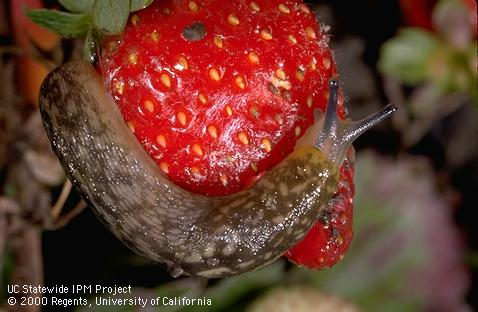
- Among the most despised garden pests they emerge from hiding at night and generally use their scraping mouths to munch their way through the garden by chewing holes in leaves and flowers of succulent garden plants and fruit.
- Snail and slugs are similar in structure and biology with the slugs lacking the external spiral shell.
- To view these pests at work you must observe them at night. Look for their signature ‘slime' trails during the daylight hours.
- To curtail infestations remove any hiding places like leaf debris, weedy areas, ivy and wood piles.
- Place your garden in the sunniest areas and keep clear of any sheltering plants or ground cover.
- Reduce moist surfaces by using drip irrigation systems
- When establishing the garden make sure it is mollusk free by surrounding it with a 4-6 inch copper band buried an inch below the ground and bent over. A similar band can be attached around the top edge of any raised beds.
- Consider snail-proof plants with stiff leaves and highly scented foliage
- Hand removal of snails and slugs is the best and easiest option.
- Pesticide baits will not work unless you remove their sheltering places in the landscape.
- Iron phosphate baits are safe for use around family and pets. Follow package instructions.
http://ipm.ucanr.edu/QT/snailsslugscard.html
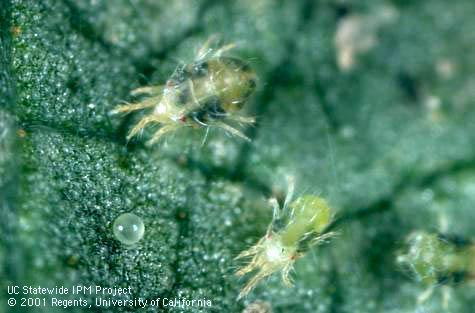
- Tiny and difficult to see, these pests are common in fruit trees, vegetables, berries, vines and ornamental plants.
- Spider mites are arachnids just like spiders and ticks.
- They live mostly under the surfaces of leaves in dense colonies of possibly hundreds of mites.
- Heavy infestations feature dense webbing that can cover leaves, twigs and fruit.
- Spider mites are sucking insects. Damage first appears as a stippling of light dots in leaves and if heavily infested the leaves will turn yellow and fall off. Check the underside of leaves to view the tiny spider mites.
- Plants that are water stressed or experiencing hot dusty conditions are most susceptible.
- Spider mites have many natural enemies. These include predatory mites, thrips, lacewings, and minute pirate bugs
- To help curtail infestations of spider mites in your plants, keep dust down, plant ground covers, use mulches and irrigate regularly to avoid drought stress.
- Use a directed water spray on the undersides of the infested plant's leaves once a day to help remove spider mites.
- If you are sure the plants are infested a good choice would be to spray insecticidal oil and/or soap on the undersides of leaves. Only use this method if the plants are not drought stressed or the weather is not hot.
http://ipm.ucanr.edu/PMG/PESTNOTES/pn7405.html
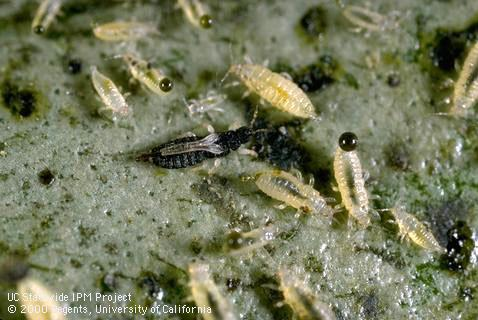
- When thrips feed they distort or scar leaves, flowers or fruit. Healthy woody plants usually tolerate thrips though the damage can be unsightly. Fruits and vegetables can suffer more serious injuries.
- You will often notice the damage before seeing these tiny slender insects
- Look for scabby, silvery discolorations on fruit, leaves or petals, excrement on fruit or leaves and curled distorted or dead shoot tips and leaves.
- On a positive note, there are certain thrips that are beneficial predators of some insects and mites. More on those in next week's posting.
- Confirm thrips infestations before taking any action as harsh weather, poor plant care, pathogens and other invertebrates can cause similar damage.
- Shake the plant over white paper to see any dislodged thrips and hang sticky tape to capture flying thrips.
- Avoid overwatering and applying nitrogen fertilizer. Prune off any declining, injured or infested plant parts
- Use floating row covers and reflective mulches
- Use the least toxic method to conserve natural predators and parasites. If pesticides are used, wait until next season and spray new growth.
http://ipm.ucanr.edu/QT/thripscard.html
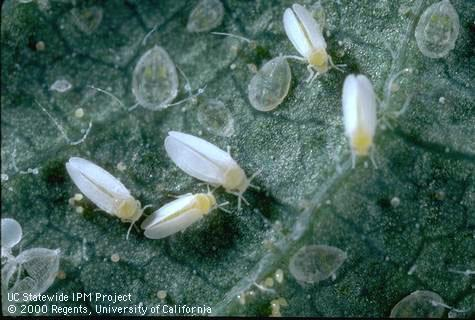
- Tiny sap-sucking insects: Adults fly around plants when disturbed and nymphs don't move, but cause most of the damage.
- Nymphs can be found on the undersides of leaves and secrete honeydew on leaves, fruit and under plants which then is covered with black sooty mold. Some species deposit a white wax on plants.
- Damage caused by the whitefly nymphs is yellowing, silvering or drying out of leaves.
- Inspect new plants for whiteflies before purchasing
- Prune any infested leaves when damage is detected and hose off adults with a strong stream of water.
- Promptly destroy any infected plants. Do not put in compost.
- Use of sticky traps, insecticidal soaps or oils and reflective mulch are deterrents.
- Avoid use of pesticides to protect the natural enemies populations.
http://ipm.ucanr.edu/PMG/PESTNOTES/pn7401.html
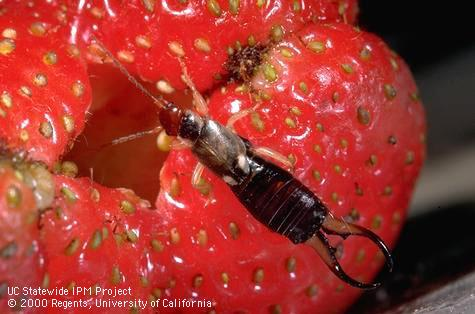
- Fierce looking, but not harmful to humans.
- Feed at night on seedling vegetables and chew holes in annual flowers, soft fruit and corn silks.
- Also considered beneficial because they also feed on aphids and other insects.
- Earwigs hide during the day in dark, cool, moist places in the landscape. They also hide in vegetables and flowers.
- Best control method is to remove hiding places and moist areas.
- Start a trapping program to have the best result. Continue to trap earwigs until traps are empty.
- Use drip irrigation when possible and use sticky substances as Tanglefoot around trunks of fruit trees.
- Insecticides should rarely be needed.
http://ipm.ucanr.edu/PMG/PESTNOTES/pn74102.html
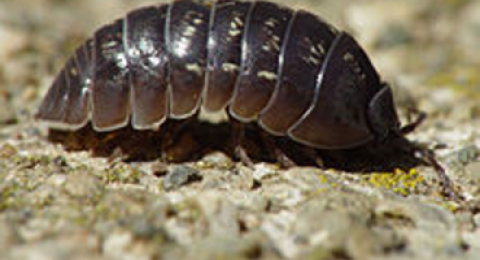
- Sow bugs and pill bugs are not actually insects or true bugs, but soil-dwelling crustaceans.
- Feed mostly on decaying plant material. They can also chew on fruit, succulent plant parts, seedling and vegetables that touch damp soil.
- When disturbed the pill bugs commonly curl into a ball thus the nickname ‘rolly polly'. The Sowbugs cannot roll so they just normally scurry away when exposed.
- Adults of both can live from 2 to 5 years.
- Since their favored food source is decaying plant material, they are important decomposers but they are somewhat indiscriminate. When confronted by succulent plant material resting on the soil, they often chow down making them a nuisance.
- To control sowbugs and pill bugs reduce decaying moist organic matter in the garden.
- Use irrigation to support healthy plants, but not increasing sustained moist areas. Water early in the day to allow excess moisture to evaporate.
- Keep compost and mulch away from the base of plants and building foundations
- Start a trapping program to have the best result. Continue to trap the pill bugs and sow bugs until the traps are empty.
http://ipm.ucanr.edu/PMG/PESTNOTES/pn74102.html
This concludes the dirty dozen postings. We have discussed twelve common invertebrate pests in our area: aphids, ants, cabbage worms, grubs, scale insects, snails & slugs, spider mites, thrips, whiteflies, earwigs and sow bugs and pill bugs. Armed with this information we hope that you now can identify these pests and begin your management program.
Help is on the way! Our next posting will talk about all the wonderful natural enemies mother nature has provided to help curtail this dirty dozen: the convergent lady beetle, green lacewing, predaceous ground beetle, assassin bug, pirate bug, soldier beetle, spider, syrphid fly, six-spotted thrips and predatory (parasitic) wasps.
Napa Master Gardeners are available to answer garden questions by email: mastergardeners@countyofnapa.org. or phone at 707-253-4143. Volunteers will get back to you after they research answers to your questions.
Visit our website: napamg.ucanr.edu to find answers to all of your horticultural questions.
Photo credits: Jack Kelly Clark, University of New Hampshire
Information Links:
UC Home Site for information on managing pests in the home, garden, turf and landscape: http://ipm.ucanr.edu/PMG/menu.homegarden.html
Pest Notes Library http://ipm.ucanr.edu/PMG/PESTNOTES/index.html
Plant Disease information: UC IPM Plant diseases http://ipm.ucanr.edu/PMG/diseases/diseaseslist.html
How to manage pests http://ipm.ucanr.edu/TOOLS/TURF/PESTS/innem.html